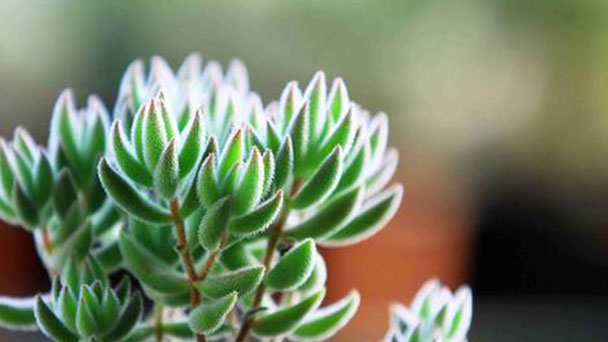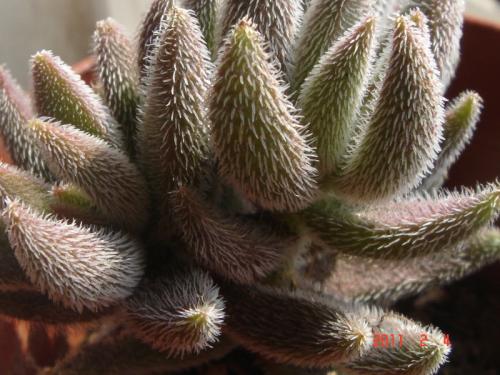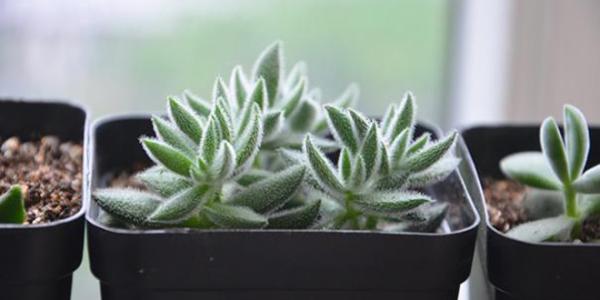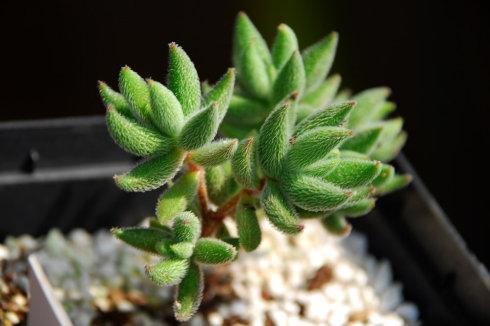Crassula mesembrianthoides profile
Written by Maggie
Mar 24 2021

Crassula mesembrianthoides is a small branched fleshy shrub of the genus Sedum in the family Sedum. Crassula mesembrianthoides is native to South Africa and cultivated in China as a small family succulent potted flower. Crassula mesembrianthoides usually uses the branch and leaf cuttings propagation, the suitable growth temperature 15-25℃. Crassula mesembrianthoides likes warm and dry and sunny environment, afraid of low temperature and frost and snow, resistance to half shade, no obvious dormant period. The basin soil can be watered thoroughly after drying, usually twice a month. It has a short dormancy during high temperatures in summer and a growing season in winter.
Crassula mesembrianthoides picture

Morphological characteristics of Crassula mesembrianthoides
Crassula mesembrianthoides can grow up to 40 cm tall, which is not the height of a small potted flower; Leaves are sessile, dense, fleshy, linearly triangular to linearly elliptic, apical, densely white tomentose. The main growing season of the crassula mesembrianthoides is in autumn and spring, and the flowers bloom from late summer to fall
Crassula mesembrianthoides life habits
Crassula mesembrianthoides prefers sunshine, and it is green in daily life. It will slowly change color after the increase of sunshine time and temperature difference. Crassula mesembrianthoides likes full sun, likes dry and warm growing environment. There is little demand for water, and too much water is prone to disease and waterlogging.The high temperature in summer has a short dormancy, pay attention to reduce watering, winter can continue to grow.
Time of sunshine: All sunshine is available outside Xinjiang, and shading is needed in summer in Xinjiang.
Water: Water twice a month.
Crassula mesembrianthoides main value
- 1. Ornamental effect of Crassula mesembrianthoides. The leaves of Crassula mesembrianthoides are covered with grayish-white hairs and are green in color. When exposed to sunlight, they turn red, purple, etc., and are known as chameleons. Putting such a chameleon on the balcony, desk, windowsill, tea table, study, sitting room, it is chic the small potted landscape that nourishes an eye, has ornamental sex extremely.
- 2. Horticultural effects of Crassula mesembrianthoides. When Crassula mesembrianthoides was introduced to China, it became popular among flower lovers and was often bred with silk and black prince to produce a wonderful combination effect.
- 3. Purification effect of Crassula mesembrianthoides. Crassula mesembrianthoides is a powerful formaldehyde absorbent, which is very effective in cleaning the air. On your computer desk, it also absorbs radiation and gives your skin fresh air. Cultivate a pot of Crassula Mesembrianthoides to refresh the eyes, freshen the air, freshen the heart, and float in the greenery.

Methods of growing Crassula mesembrianthoides
Soil selection
Crassula mesembrianthoides can be grown with a mixture of peat, vermiculite and perlite, or a mixture of peat and coarse sand.
Light and temperature
Crassula mesembrianthoides prefers a warm, dry, sunny environment and is green in daily life, which gradually changes color as the duration of sunlight increases and the temperature difference increases. Full sunshine is available. Crassula mesembrianthoides require full sun exposure for a compact and beautiful plant shape. Too little sunshine leaves are very easy to arrange loose, slender leaves. In addition, it is afraid of low temperature, frost and snow, and resistant to semi-shade. Its native place is located in southern Africa and South Africa. There is a short dormancy in the summer heat. Crassula mesembrianthoides grows at a temperature of 15 to 25 degrees Celsius, and not less than 5 degrees in winter.
Sewage sludge management
Crassula mesembrianthoides don't need much water, and too much water is prone to disease and waterlogging. Growing season watering general dry thoroughly watering thoroughly, keep basin soil dry in winter.High-temperature dormancy in summer, pay attention to reduce watering, winter can continue to grow. Spring and autumn growing period fertilization are usually every 2 months.
Propagation method of Crassula mesembrianthoides
Crassula mesembrianthoides thrive in groups, mainly from cuttings, but also from leaves. It can be carried out all the year-round, with fast rooting in spring and autumn and a high survival rate. Crassula mesembrianthoides can also propagate by beheading, dividing plants and sowing seeds.

Latest Updated
- Benefits of Bugleweed - 7 Science-backed Health Benefits
- Bugleweed Dangers & Side Effects - Is It Poisonous?
- How to Plant Evergreen Trees - What You Should Know
- When to Plant Evergreens - Grow Guide for Evergreen Trees
- 12 Wonderful Evergreen Shrubs for Your Garden
- 12 Popular Evergreen Plants with Pictures for Beginners
- When And How To Prune A Lilac Bush Like a Pro
- How to Grow & Care for Lilac Vine (Hardenbergia Violacea)
- Japanese Lilac Tree (Syringa Reticulata) Care & Propagation Guide
- Shumard Oak Pros and Cons - What to Know
Popular Articles
- Winter maintenance of Antirrhinum Majus
- How to Grow Terminalia Mantaly Tree
- How to Grow and Care for Crossostephium Chinense
- How to grow Antirrhinum Majus in spring
- Peristeria Elata (Dove Orchid) Profile: Info & Care Guide
- Underwatered Snake Plant (Sansevieria Trifasciata) - Signs And How To Fix
- How to Care for Brazilian Jasmine Plant (Mandevilla Sanderi)
- How to Grow & Care for Graptopetalum Purple Delight in Summer
- Rosa Chinensis (China Rose): Plant Growing & Care Tips
- How to Care for Baby Sun Rose (Aptenia Cordifolia)